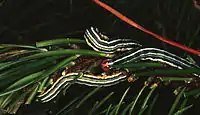| Pine beauty | |
|---|---|
 | |
| Scientific classification | |
| Domain: | Eukaryota |
| Kingdom: | Animalia |
| Phylum: | Arthropoda |
| Class: | Insecta |
| Order: | Lepidoptera |
| Superfamily: | Noctuoidea |
| Family: | Noctuidae |
| Genus: | Panolis |
| Species: | P. flammea |
| Binomial name | |
| Panolis flammea (Denis & Schiffermüller, 1775) | |
The pine beauty (Panolis flammea) is a moth of the family Noctuidae.[1][2] It is a common species of pine woods in Europe. The distribution area extends from Portugal to western Siberia, the Caucasus and Asia Minor. In the north it extends to the Arctic Circle, in the south it is found in Ceuta in Northern Africa[3] in and southern Italy (including Sicily and Sardinia).



The forewings are typically rich orange brown, but sometimes are dark grey, with two large pale stigmata and fine streaks along the termen. The hindwings are brown or blackish.
Technical description and variation
The wingspan is 32–40 mm. Forewing orange rufous with some ochreous admixture; the veins dotted grey and white; the inner and outer lines deeper rufous, conversely edged with white, and dentate lunulate; submarginal line pale, preceded by a dentate rufous shade; the terminal area often paler; stigmata large, irregular; the claviform with some pale and brown scales at its extremity; orbicular and reniform pale rufous with deeper centres, the orbicular flattened, its lower edge often produced along median vein as a streak and connected with reniform, which is large with the upper end angularly produced outwards; fringe mottled rufous and white hindwing fuscous, often with a reddish tinge; the ab. griseovariegata Goeze has the rufous tints obscured by glaucous grey and fuscous.[4]
Biology
This moth flies at night from March to May and is attracted to light and sallow blossom.
Larva bright green with the lines broadly white edged with deep green; spiracular line edged below with yellow. It feeds on the needles of Pinus sylvestris and other pines, but sometimes on other trees (see list below), and can be a serious pest in forests. The species overwinters as a pupa.
- ^ The flight season refers to the British Isles. This may vary in other parts of the range.
Recorded food plants
- Abies – fir
- Betula – birch
- Chamaecyparis
- Juniperus – juniper
- Larix – larch
- Picea – spruce
- Pinus – pine
- Pseudotsuga – Douglas-fir[5]
- Quercus – oak
See Robinson, G. S. et al.[6]
References
- ↑ Michael Chinery, 1986
- ↑ Bernard Skinner, 1984
- ↑ Yeray Monasterio León et al. Primer registro de Panolis flammea ([Denis & Schiffermüller, 1775) (Lepidoptera: Noctuidae) para el continente africano]. Boletín de la SEA, ISSN 1134-6094, Nº. 66, 2020, págs. 273-275
- ↑ Seitz, A. Ed., 1914 Die Großschmetterlinge der Erde, Verlag Alfred Kernen, Stuttgart Band 3: Abt. 1, Die Großschmetterlinge des palaearktischen Faunengebietes, Die palaearktischen eulenartigen Nachtfalter, 1914
- ↑ C. Michael Hogan (2008) Douglas-fir: Pseudotsuga menziesii, globalTwitcher.com, ed. Nicklas Strõmberg Archived 4 June 2009 at the Wayback Machine
- ↑ "Robinson, G. S., P. R. Ackery, I. J. Kitching, G. W. Beccaloni & L. M. Hernández, 2010. HOSTS – A Database of the World's Lepidopteran Hostplants. Natural History Museum, London".
- Chinery, Michael Collins Guide to the Insects of Britain and Western Europe 1986 (Reprinted 1991)
- Skinner, Bernard Colour Identification Guide to Moths of the British Isles 1984
External links
- Funet Taxonomy
- Beccaloni, G.; Scoble, M.; Kitching, I.; Simonsen, T.; Robinson, G.; Pitkin, B.; Hine, A.; Lyal, C., eds. (2003). "Panolis flammea". The Global Lepidoptera Names Index. Natural History Museum.
- Lepiforum.de
- Vlindernet.nl (in Dutch)